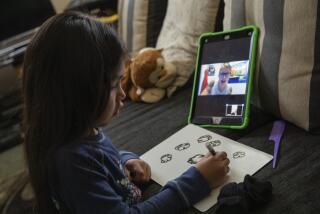Putting Broadband on the Air
Despite all the hype about high-speed Internet access, most people who want faster connections at home face initial waits that make their trusty dial-up modems seem downright speedy.
That’s because they have to wait--sometimes for months--for their local phone company to bring digital subscriber line (DSL) technology to their neighborhood or for their cable operator to offer cable modem service.
But little by little, wireless technologies are emerging that could quicken the spread of broadband access.
Two of the nation’s largest long-distance companies, Sprint Corp. and AT&T; Corp., are launching residential services that use so-called fixed-wireless systems to deliver faster Web connections without stringing wires to every home in America. WorldCom also holds fixed-wireless licenses, but the company’s roll-out plans are unclear.
Wireless technologies have definite limitations, but so do their “wired” alternatives. Fiber-optic lines remain pricey; DSL speeds are distance-sensitive and can be affected by poorly maintained copper phone lines; and cable modem networks share the last leg of the connection with the whole neighborhood, slowing speeds for everyone during peak usage.
“Between cable modems, DSL and fixed-wireless, it’s pick your poison. You’re going to have similar levels of service, but different things are going to cause problems,” said Tim Burke, telecommunications analyst at Edward Jones. “No one’s going to be 100% happy with what they’re using.”
Different broadband systems probably will coexist for the next few years by targeting the markets best-suited to their technological strengths and by filling service gaps left by other systems. But it will take time.
“Most people have a choice of zero forms of broadband to this day,” said Timothy Sutton, president of Sprint’s broadband wireless group. “There is going to be something north of 50 million households that cannot get any broadband for the next few years, so it’s a huge market for us.”
Sutton’s group hopes to tap those unserved homes using fixed-wireless technology that can deliver Internet connection speeds comparable to--and often faster than--competing technologies. The company holds licenses for wireless service in 90 U.S. markets, an area covering 30 million potential customers.
Sprint launched its first system in Phoenix in May, and has signed up about 10,000 customers so far, Sutton said. The company recently expanded into Colorado Springs, Colo., Tucson, Detroit, Houston, San Francisco and San Jose and plans to be in more than 40 markets by the end of next year.
Sprint’s service uses a section of the radio spectrum originally set aside for wireless delivery of cable programming. That market never developed and federal regulators allowed license owners to shift to two-way Internet offerings.
The basic system starts with a central antenna or transmitter mounted on a tall radio tower, typically one that is already in use for television or radio transmissions. Outside a customer’s home, the company mounts a small, flat, diamond-shaped antenna so that it has a clear transmission path to the tower.
Inside, the setup is similar to that required for DSL or cable modem service: It includes a wireless cable modem and installation of software and a computer network interface device inside the computer.
The Phoenix offering costs $39.95 per month and includes Internet service from EarthLink Sprint with typical download speeds from 512,000 bits per second to 1,500,000 bps--about 18 to 52 times faster than a dial-up modem running at 28,800 bps.
Installation fees, which are sometimes waived, run $299, and equipment costs range from $99 to $299, depending on the service contract.
A single tower can serve customers up to 35 miles away, covering about 3,000 square miles--a fact that allows Sprint to enter new markets quickly and at relatively low cost.
The primary drawback of Sprint’s service is its susceptibility to obstructions such as dense woods, tall buildings, neighboring houses or mountains.
Rival AT&T; is shifting into commercial operations with its wireless broadband service after a lengthy test in Dallas and Fort Worth. The system, originally code-named “project angel,” uses a cellular-like technology in some markets and a system similar to Sprint’s in other markets.
The cellular-like system requires AT&T; to build out its coverage area in “cells,” each with a base station that sends and receives data to and from customer homes in much the same way that mobile services transmit signals to and from wireless phones.
AT&T;’s service is being advertised only in its original Dallas market, but it has begun installations in San Diego and will move to Los Angeles, Houston and Anchorage next. The company hopes to be able to reach 15 million potential customers by the end of 2002.
Prices will vary by region, but AT&T;’s San Diego service costs $54.45 per month and includes Internet service from AT&T; WorldNet and the ability to connect several computers at shared download speeds of up to 512,000 bps. A planned upgrade would boost download speeds to 1 million bps, but sending data to the Internet would be significantly slower at 128,000 bps.
AT&T;’s wireless broadband package also includes phone services, with unlimited local calling, two phone lines and long-distance service at 7 cents per minute for state-to-state calls and 5 cents per minute for in-state calls. Three add-on phone features, such as call waiting, are included on one line for free for a limited time.
Both Sprint and AT&T; face installation difficulties because both require the mounting of an antenna at the customer’s home, but analysts expect the fixed-wireless systems to play an ever-larger role in broadband service. Brian Gilman, senior analyst at market research firm EMarketer Inc., estimates that fixed wireless systems will have 80,500 residential customers by the end of this year, rising to around 770,000 users in 2003.
“As more players get in here, the market is going to get very competitive, and prices are going to drop [for high-speed access],” Gilman said. “But the key word is patience.”
*
Times staff writer Elizabeth Douglass can be reached at [email protected].
(BEGIN TEXT OF INFOBOX / INFOGRAPHIC)
Going Broadband
Residents craving high-speed Internet access now have another choice besides digital subscriber line (DSL) technology and cable modems. In a handful of cities, Sprint Corp. and AT&T; Corp. are launching new wireless systems that offer customers fast Web connections through small home-mounted antennas. Below, a comparison of the two rivals’ services.
*--*
Sprint Broadband AT&T; Digital Broadband (Phoenix package) (San Diego Package) Monthly service fee: $39.95 $54.45 Installation charges: $299 (Waived in some Waived promotions Equipment charges: $99-$299 Waived in initial markets Connection speeds for downloading: 512 kbps to 1,500 kbps Up to 512 kbps Internet service: EarthLink Sprint AT&T; WorldNet Computer connections: 1* Up to 5 Extras: 6 megabytes Web 2 phone lines,* unlimited storage, 6 personal free local calling, start pages, 5 hours long-distance calls at dial-up access, 7 cents a minute state- warranty on to-state; 5 cents a minute equipment. for in-state
*--*
Residential setup:
Sprint: Antenna mounted near home roof line, wire into home to wireless cable modem. Cable modem connects to computer. Works with Windows and Macintosh computer systems.
*
AT&T;: Antenna mounted under home roof line, wire into home to indoor unit. Indoor box connects to computer and to existing phone wires to allow multiple computer connections. Works with Windows systems only.
Sources: Sprint and AT&T;
(BEGIN TEXT OF INFOBOX / INFOGRAPHIC)
How Broadband Wireless Works
The wireless networks used by Sprint and AT&T; to deliver residential broadband services--offering high-speed Internet access--have similar systems. Here is how a typical home setup would work:
1. RESIDENTIAL
AT&T; or Sprint installs a small antenna atop the customer’s house and hooks up a modem for the computer. The company must also install special software to work with the modem.
2. RADIO LINK
When the customer turns the computer on, the Internet connection is instantaneous. Whenthe user clicks a button to retrieve a Web site, the modem funnels the request to the home antenna, which then sends it through the air to the closest main antenna for Sprint or AT&T.;
3. SWITCHING CENTER
From the company’s antenna, the user’s request travels (as a packet of data) over fiber-optic lines to the closest communications switching center.
4. INTERNET
The center has a direct connection to high-capacity lines known collectively as the Internet backbone. Once the customer’s requested Web site is found, the pictures and other data travel back to the user’s computer by reversing the route.
Sources: Sprint and AT&T;
More to Read
Inside the business of entertainment
The Wide Shot brings you news, analysis and insights on everything from streaming wars to production — and what it all means for the future.
You may occasionally receive promotional content from the Los Angeles Times.









